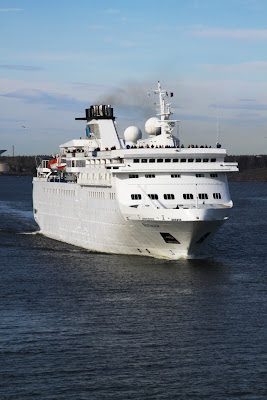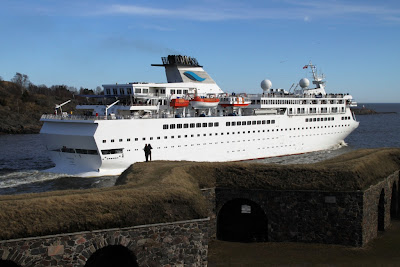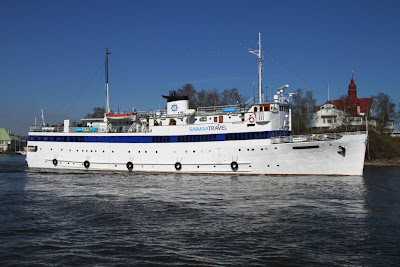Helsinki's 2013 summer cruise season started a week ago, when Transocean Cruises'
Astor made the season's first cruise call. I did not have a chance to photograph the
Astor, but today saw the season's second cruise call in the form of Voyages of Discovery's
Voyager making her maiden call to Helsinki (at least under her current name).
Unrelatedly to the above, the 2/2013 issue of Ulkomatala came out earlier this week. Those of you who speak Finnish can read the magazine by
clicking on this link. The latest issue features, amongst others, my article about the Spirit of Tasmania and Pelni ferry operators.
Voyager
IMO 8709573
Name history:
Crown Monarch, Nautican, Walrus, Jules Verne, Alexander von Humbold, Voyager
Built 1990 Union Naval de Levante Valencia, Spain
Tonnage 15 271 GT
Length 152,50 m
Width 20,60 m
Draught 5,80 m
556 passengers (lower berths)
4 Normo-Bergen diesels, combined 13 240 kW
2 propellers
2 bow thrusters
Speed 18 knots
Voyages of Discovery's
Voyager started life back in November 1990 as the
Crown Monarch of Crown Cruise Line, and she was used for cruising from Florida to the Caribbean. At the time of the ship's delivery Crown Cruise Line was owned by Grundstad Maritime of Norway, but in July 1991 the line was sold to the Finland-based EffJohn, who were looking to expand their international cruise operations. The sale had no immediate effect on the
Crown Monarch, but in 1992-1993 she got two new fleetmates,
Crown Jewel and
Crown Dynasty (today the
Gemini and
Braemar, respectively)
EffJohn was experiencing acute financial difficulties in the early 1990s and a partner was sought for the Crown Cruise Line outfit. This was found in the form of Cunard Line and the result was the formation of a joint venture, Cunard Crown Cruise Line. The
Crown Monarch and her fleetmates kept their names (although were marketed with "Cunard" prefixes in their names), but recieved Cunard funnel colours. The three Crown ships were joined in the Cunard Crown fleet by the
Cunard Countess and
Cunard Princess.
The Cunard Crown collaboration proved to be a short one, as EffJohn decided divest themselves entirely from their international cruise operations in 1994. The
Crown Monarch was chartered after the 1994 summer season to a Far-eastern cruise operator as the
Nautican for cruising out of Singapore. In 1996 she was renamed
Walrus and in 2001 moved to casino cruising out of Hong Kong. Through-out these years the ship was owned by the same company, although it changed names several times during the years, being known as EffJohn, Silja, Neptun Maritime and (again) Silja. In 2005 Silja's then-owner Sea Containers decided to sell Silja Line's operations. The ship's not in service with Silja Line (
Finnjet, Silja Opera and
Walrus) were transferred under Sea Containers' direct ownership prior to the sale.
Silja Line was sold to Tallink in July 2006 and in the end of the month the Walrus also found a new owner, the new Netherlands-based Club Cruise. In April 2007 the ship was renamed
Jules Verne (quite possibly the greatest cruise ship name of all time!) and chartered to the Spanish-market Vision Cruises. In March 2008 the
Jules Verne was chartered to Phoenix Reisen and renamed
Alexander von Humbold (she was initially marketed as the "Alexander von Humbold II" but does not appear to have ever officially carried the numeral). In late 2008 Club Cruise went bankrupt and the
Alexander von Humbold was laid up in Bremerhaven, Germany.
In November 2009 the
Alexander von Humbold was sold at an auction to All Leisure Group, but she was chartered again to Phoenix Reisen for 2010. This was followed by a charter to the Turkey-based Bamtur. Finally in late 2012 a refit started to turn the
Alexander von Humbold into the
Voyager, the new ship of the Voyages of Discovery cruise line owned by All Leisure. The
Voyager entered service with Voyages of Discovery in December 2012.
The photographs below show the
Voyager departing Helsinki South Harbour on the 4 May 2013, her maiden call to the port under her current name. Photographed from Kustaanmiekka. Click on the images to see in larger size.
 |
| Upright photos are good in case we ever need them for the cover of Ulkomatala. And they look good too. |
 |
| Voyages of Discovery decided to paint the ship all-white (all previous incarnations had a stripe on the hull) and it doesn't really improve the ship's looks. All-white looked good on the company's earlier (and older) Discovery, but the boxier Voyager really calls out for the stripe. |
 |
| The ship's maiden call lured many photographers out from hibernation. |
 |
| Early spring in Helsinki unfornatately doesn't look that impressive. |
 |
| While I'm complaining about the ship's looks, the funnel symbol really looks like it should be mirrored. This way it looks like it's the wrong way around (even if it appear this way 'round on the Voyages of Discovery logo). |
 |
| Notice the rather unsual duck tail/sponson aft. |
Next time: Still a mystery even to myself.

























